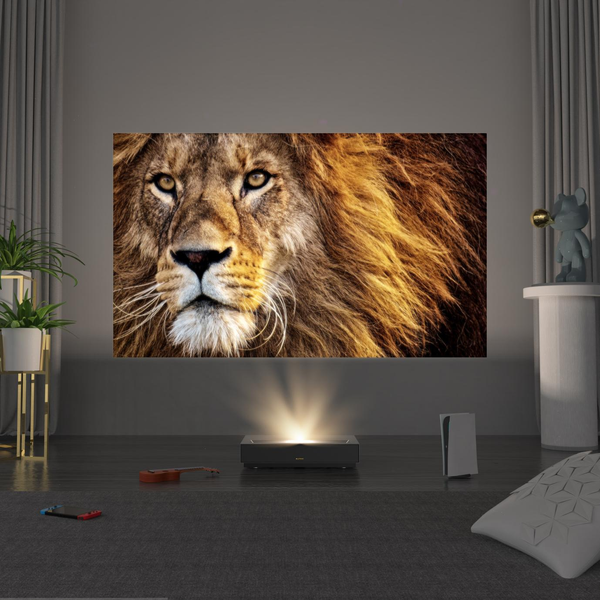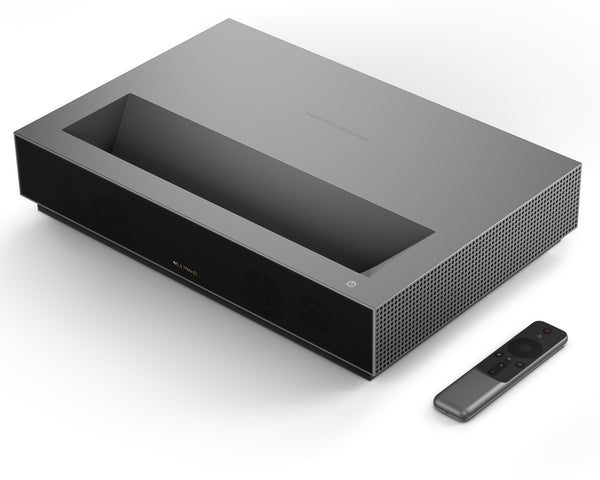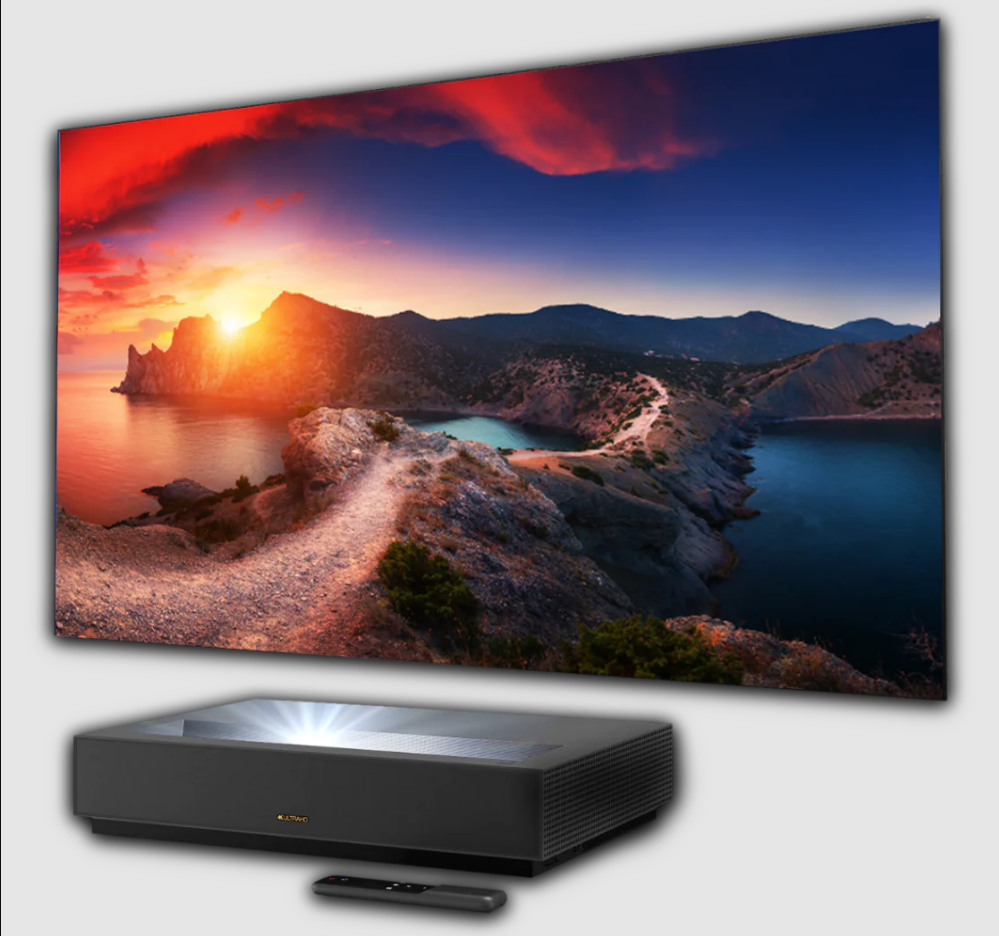With a laser TV projector, you get a 100-inch + screen size, eye-catching picture quality, and literally cinema-grade viewing experience. The competition-OLED brings exceptional contrast, deeper blacks, and superlatively vibrant colors to the table.
In terms of technology, there have been significant advances on both sides of the fence, hence a myriad of features and phenomenal performance are a given. So, it's harder now than ever before to get a clear winner to the great laser projector vs. OLED debate.
Actually, there will be a tradeoff no matter which way you go. And that's what makes it vital to understand the key differences between these products and technologies. So, continue reading to get a clear picture from the laser TV vs. OLED comparison; one that will help you to make the right buying decision.
What is a Laser TV Projector?

A new class of display devices, laser TV projectors combine an intense laser-powered light source with a DLP chip or LCD panel to produce crisp and color-rich images.
These are typically ultra-short throw or short throw units that can be placed a mere 5 to 60 inches from the screen and don't need to be ceiling mounted.
All projectors, no matter what the technology at their core, use a light source that produces single/multiple beams that are fed to a spinning wheel or a prism. The light beam is then passed to an optical projection unit like a DMD chip or an LCD panel.
A data formatter is used to convert binary data and relay it to control memory cells. These cells then use the optical projection unit to create an image with the help of the light beam. The image, thus created, is then sent through a front lens so that it can be projected onto a screen.
Until a few years ago, metal halide lamps and halogen bulbs were used as light sources for projectors. Not only were they prone to frequent burnouts and intense heat generation but also they were simply not bright enough to compete with Led and LCD TVs.
But all of that changed when laser was brought into the equation. The laser TV projectors of today are super bright. Hence, their performance does not get degraded easily or significantly even when faced with ambient light.
Moreover, laser as a light source does not generate as much heat, hence it is more energy efficient and lasts only about 10 times longer than metal halide and halogen bulbs.
So you could say that a laser TV projector combines several cutting-edge technologies and high-quality components that together offer never-before-possible picture quality. And if that's not enough, these units also bring several other benefits to the table, more on that later...
What is an OLED TV?
This is a television display technology that is powered by organic light-emitting diodes (OLED). Conventional LED-LCD displays need a backlight, which is a light-emitting diode, to work. In contrast, OLED panels are capable of autonomously generating light when a current is applied to them.
An LED display uses a light-emitting diode as a backlight to feed an LCD panel. This backlight is what powers the pixels which then open/close as required to get the colors needed to reproduce the image.
However, OLED displays do not need a backlight. They involve the use of a semiconducting material sandwiched between two conducting elements. When current is applied to it, the semiconducting material gives off an intensely bright light.
Because the emission of light is done by the diode assembly, it is possible to completely switch off or on each pixel. This means that the display and hence the reproduction of the colors and the image can be controlled down to each individual pixel.
Laser TV Projector vs OLED
Quick Laser vs. OLED Features Comparison
|
|
Laser TV Projector |
OLED TV |
|
Picture Quality |
High contrast, wide color gamut, excellent color accuracy. |
Best for color gamut, saturation, and crispness. |
|
Size & Placement |
Screen size up to 150" with flexible placement. 6' viewing distance for 100". |
Largest size 97". 3.5'-5' viewing distance for 60"-85". |
|
Price |
Ranges from $1,600 to $4,000 depending on features. |
$900 for basic 65", up to $25,000 for 97" with features. (Yes, those are three zeros!) |
|
Longevity |
20,000-25,000+ hours lifespan. |
Typically 30,000 hours lifespan. |
A Laser TV Projector Provides Better Viewing Experience
The contrast ratio: In all honesty, a laser projector, no matter how high-end it is, will never offer the same contrast ratio or color gamut as an OLED TV.
Particularly when it comes to laser projector vs. OLED contrast ratio, there really is no competition since the former offers a contrast of 3000:1 while OLED boasts infinite contrast ratio.
As far as actual viewing performance goes, this results in the deepest deep blacks that neither LED TVs nor the best laser projectors are capable of. But, the overall image quality is about more than just the contrast ratio.
The color gamut and accuracy: Yes, OLED does offer more on this front too. But, opt for a DLP projector and you will get well over 1 billion colors. So, in terms of what your eyes can discern, the color accuracy of a laser projector will be at par with that of OLED.
Color saturation and brightness: On this front, DLP+ laser projectors are clear winners. In fact, when it comes to color saturation, few other display technologies can compete with the combination of DLP and laser.
Without a doubt, OLED produces more vibrant colors given the higher contrast ratio. But, the intense brightness of laser projectors more than covers this deficit. The net effect is brilliant picture quality.
The size: What a laser projector lacks in contrast ratio and true black, it makes up for in size. Because at least at this time, you can't possibly get to a 100-inch OLED screen, let alone a gigantic viewing space of 150 inches, you can only get a true big-screen cinematic experience from a projector.
Resolution: Gone are those days when projectors were lagging behind with 1080p resolutions while OLED was at the top of its game with 4K performance. Today, you can get 4K UHD performance from a high-quality laser projector with HDR 10 capabilities to boot.
A Laser TV Projector Is Adaptable Anywhere In Your Home
You may feel that setting up a TV is as simple as plopping the unit on the console while a projector must call for a more time-consuming and complicated installation process.
As long as you are dealing with a 45-inch TV, why only the console even wall mounting can be easily accomplished. The problem starts when you move to bigger sizes. That's when the dimensions and the weight of the unit make the task complicated.
For instance, you would not want to keep a 75-inch beast of an OLED on the console if you have young kids or pets who can get adventurous with it. Wall mounting it can be cumbersome and is certainly not a one-person job.
Finally, let's not deny the fact that when switched off, a TV is just an ungainly, large black square that hogs up a lot of space on the display wall of your living area.
Now, without a doubt, ceiling mounting a projector is no mean task, but if you opt for an ultra-short throw projector, you will have nothing to worry about.
For starters, the unit can be placed a mere 5- 9 inches from the screen to project a display size of 80-100 inches. Moreover, the unit itself is unlikely to weigh more than a few kilograms (full-size, non-portable unit).
The projector can easily be made a part of your existing home theater setup. You could place it to the side or right in the center. If you don't have a console, a tripod can be used just as easily.
Because there is no setup involved and just 1-2 cables to deal with (Power and HDMI), you can easily move the unit to any room in the house without breaking a sweat.
Yes, you will need a screen, no arguments there. But, you can take your pick from a range of fixed and retractable screen options. In fact, even within the retractable screen category, you get a myriad of choices.
Now, much is made about the pitch-dark environment needed to get good image quality from a projector. But that again is a thing of the past. No, you still can't keep all the lights in the room on and all blinds/curtains open.
But the fact that the projectors of today are significantly brighter than their predecessors makes them much more tolerant of ambient light. Add an ALR screen to this matrix, and you can enjoy image quality that's at par with that of a TV even when you have the lights on in the viewing area.
READ MORE: ALR vs CLR Screen: Do you Need an ALR or CLR Screen?
A Laser TV Projector is High Value for Money
As long as you are in the 55- 65 inch screen size range, an OLED TV will cost you less than a laser projector but move beyond that range and OLED units get painfully expensive. In fact, a 75-inch OLED TV can easily set you back by as much as $3000- $4000 depending on the manufacturer and features.
Move past that to an 85-inch OLED screen and you'll have to pay several times more. As opposed to this, with a laser projector, you can get a screen size of 80 -150 inches for less than $3000. Plus, you get the option to choose the screen size based on the space available without any change in cost.
So, when it comes to the laser TV vs. OLED price debate, projectors are clear winners. In terms of life span, there isn't much of a difference with OLED offering about 5000 hours more. But, because OLED is strikingly close to the plasma technology of the decade past, it is prone to pixel burnout if used for static images.
And as you may have guessed, damaged parts will be expensive to replace. In contrast, you will never have to worry about pixel burnout with a laser TV projector that is powered by DLP technology. Also, these need very little maintenance.
Now, when it comes to operating cost, OLED is more energy efficient but laser TV projectors are not too far behind and certainly an order of magnitude better than the halogen lamp-based projectors of the past.
A Laser TV Projector Is Safer For Your Eyes
Let's put it this way if the price of a big-screen OLED TV does not leave you teary-eyed, watching it for a couple of hours at a stretch certainly will.
OLED like all other televisions is a transmissive display device. What this means is that it throws the luminescence outward toward the viewer. So, your eyes bear the full brunt of the brightness. On the other hand, projectors are reflective devices.
The luminescence is aimed at the screen, so the light hits your eyes indirectly and as such is far less taxing on the peepers even at peak brightness. Moreover, the larger screen size of a laser TV projector means that as long as you have the right viewing distance, you won't be straining your eyes much.
Good Reasons to Invest in a WEMAX Laser TV Projector

It can safely be said that while a laser projector vs. OLED debate brings up several pros and cons for both sides, you are likely to get more from a projector both in terms of value for money and viewing experience.
And with that out of the way, chances are that you'll be keen on checking out the best laser TV projectors in the market- A top contender is the WEMAX Nova. A high-end product that comes from a manufacturer with decades of experience supplying display devices to cinemas across the world, the Nova brings the same impressive picture quality and superior performance that you'd expect from movie theater display devices.
In fact, the Nova has been designed to offer commercial-grade display performance with all the features that you'd want and need from a top-of-the-line home theater projector. Here is what this very popular product brings to the table:
4K UHD: As mentioned above, lower resolution was and remains one of the pain points of most midrange projectors. But, that's only if you don't have a NOVA. This DLP+ laser projector offers 4K UHD resolution which is 4 times that of Full HD. And if that's not enough, this device also offers support for HDR 10. So, with the NOVA you get crystal clear and crisp images, stunning image details, and breathtaking colors.
Visuals That Mimic Reality: Because the unit offers 1300 ANSI lumens of brightness and a native contrast ratio of 3000:1, the visuals are so lifelike that it's almost like actually being at the scene and taking it all in with your own eyes. And there is more from where that comes. DLP is known for its exceptional ability to project dark and true black, so there is no gray or blue bias to the darker tones and shadows.
Provides Endless Entertainment: Quite simply, the WEMAX Nova is all the entertainment that you will ever want, packed into one small frame. It's powered by Android TV 9, so you get access to 5000+ apps that include everything from Youtube to most OTT platforms and of course everything on the Google Play Store.
So, you can use it for regular TV shows, the latest movies, and even online learning and of course gaming. Plus, the range of connectivity ports in the design as well as its Bluetooth and WiFi compatibility means that you can effortlessly connect it to any storage device or media player.
Immersive Audio: WEMAX Nova has 30W inbuilt speakers, so nothing will come between you and an honest-to-goodness cinema-grade viewing experience. And if you desire more, you could just as easily connect a sound bar or a home theater audio system to the unit.
Wrapping it Up
By now, you will surely have the same conclusion as many others out there- That in reality there is no laser projector vs. OLED debate. Both types of devices have a distinct set of benefits and drawbacks.
Having said that, if you want greater value for money, exceptional performance, and cinematic viewing pleasure, without paying a fortune for it, a laser TV projector will be your best bet.
Things might change in the future for OLED TVs, but at this point, as the screen size increases these devices get frighteningly expensive and out of reach of most regular buyers who don't want to invest more than a few thousand into their home theater system.
Plus, with a projector, you get a range of options while an OLED is a more rigid device in terms of how it can be used and installed. So, if you are considering an upgrade to your home theater system or are building one from scratch, a laser TV projector will without a doubt be a worthy addition to it.
Related Blogs from WEMAX
LED vs. Laser Projector – Which is Better?
FHD vs UHD vs 4K: What are the Differences?
HDR vs SDR: Is SDR Better than HDR?
Be the first to know the latest updates, tips, how-tos, exclusive deals, and discounts from WEMAX. Sign up for our newsletter today!



Share:
Is a 4K Laser TV Worth It?
How Big is a 120 Inch Screen